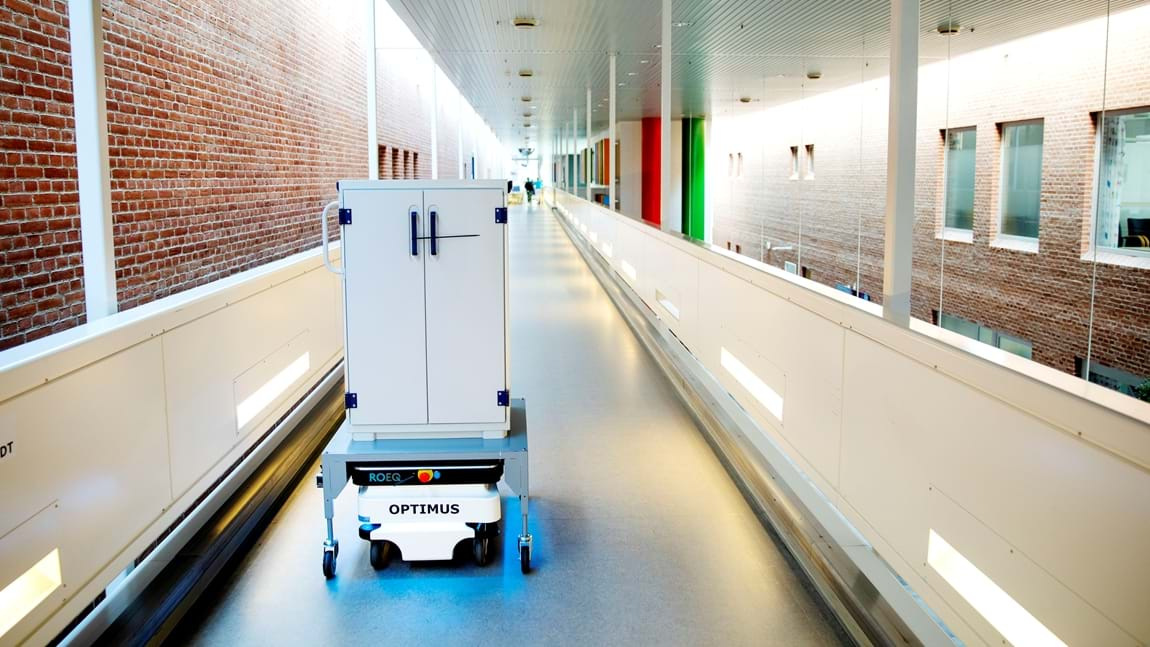Small Danish robots have put on scrubs and are ready to deliver
Sterile equipment and waste are transported around hospitals and nursing homes by small mobile robots. The result is more time for patients and lower costs. The Confederation of Danish Industry is pleased that the technologies have reached a level where it is interesting for companies to invest.
15 kilometres per day.
That is how much distance small mobile robots from companies such as Mobile Industrial Robots (MiR) cover each day transporting equipment, food, bed linens or other necessities at the country’s hospitals.
MiR robots can take the lift, drive down corridors alongside staff and patients, avoid obstacles and open doors on their own. Thomas Visti, CEO of Mobile Industrial Robots
At Zealand University Hospital, staff members at the Sterile Centre load single-use equipment and sterile instruments onto carts that are subsequently transported to the hospital by robots from MiR.
Operations Manager Johnny Petersen explains that the hospital has already benefitted greatly from introducing the automated technology.
He further explains that the hospital is improving the entire workflow and time management with more frequent and more targeted deliveries.
See also: Denmark earns millions on ISS’s job programme
Let the robots fetch it
Thomas Strecker Leitner, Market Director Hospitals Logistics Scandinavia at consultancy Rambøll notes that experience from Germany and Austria shows that automatisation of workflows at hospitals pays for itself in just four to six years.
“The cost of healthcare in Denmark is among the highest in the world, so it makes sense to save resources while also increasing quality the final steps of the way to the patient by using mobile robots instead of staff having to walk back and forth and retrieve everything from depots,” he says.
Thomas Strecker Leitner also points out that mobile robots have advantages in a number of other areas such as hygiene, timing and process. Even in maintenance, robots can help cut costs because they do not run into doors and door frames the way that manual transport often does.
See also: New map: Companies contribute DKK 550 billion to Danish welfare
Time for residents at nursing homes
At Engparken nursing home in Ikast-Brande Municipality, the robot Roberta from MiR helps staff conserve time and energy and avoid heavy lifting by removing waste.
Social care worker Dorthe Marinussen explains that before the nursing home acquired the robot, having to leave a ward to remove waste could be problematic.
“There are quite a few dementia patients here who can grow anxious and create conflict. Now I can be present in the ward all the time, because the robot automatically removes waste,” she says.
In total, Roberta saves staff 48 minutes of waste management in the course of a shift at Engparken nursing home.
Director Jakob Scharff, the Danish Service Industries Federation, is pleased that the technologies have reached a maturity and price level where it is interesting for companies to invest.
China is making major investments
Other countries have also seen the potential in the small Danish rolling robots.
The Chinese hospital sector, for example, is so hungry for Danish-produced logistics automation that CEO of MiR Thomas Visti returned from Shanghai last year with an order for 50 robots from Mobile Industrial Robots’ Chinese distributor Bionlink, which supplies equipment to hospitals.
“A major advantage is that MiR robots are built to use exactly the same access ways as humans, so hospitals don’t have to change the infrastructure of existing buildings,” says Thomas Visti, CEO of Mobile Industrial Robots.
See also: Danish companies facing pressure from China


